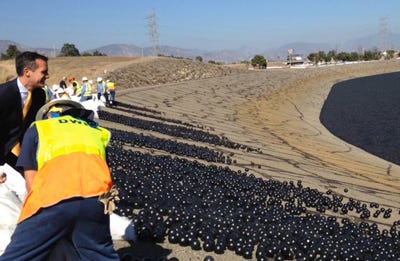Why is LA Mayor Garcetti playing with polyethylene balls?
As if Los Angeles didn't have enough water-related worries, the municipal Department of Water and Power (DWP) also has to protect the little water it does have in reservoirs from evaporation and harmful chemical reactions, such as sunlight turning bromide and chlorine into bromate, a suspected carcinogen. One remedy that the DWP has implemented is dumping four-inch-thick black polyethylene (PE) balls to cover the surface. Called shade balls, they reportedly reduce evaporation and prevent algae growth and chemical hazards.
August 11, 2015

As if Los Angeles didn't have enough water-related worries, the municipal Department of Water and Power (DWP) also has to protect the little water it does have in reservoirs from evaporation and harmful chemical reactions, such as sunlight turning bromide and chlorine into bromate, a suspected carcinogen. One remedy that the DWP has implemented is dumping four-inch-thick black polyethylene (PE) balls to cover the surface. Called shade balls, they reportedly reduce evaporation and prevent algae growth and chemical hazards. In a first for the profligate DWP, the novel water-quality protection plan costs a mere 36 cents per ball. Of course, it's buying 80 million of them, so it does add up to a tidy sum.
 Los Angeles Mayor Eric Garcetti (pictured) pitched in on August 10, helping city workers dump 20,000 balls into the Los Angeles Reservoir, which currently holds a total of 96 million balls and about one inch of water. Just kidding about that last bit. The reservoir is actually designed to hold more than three billion gallons of water, although, as the picture shows, it's nowhere near capacity right now.
Los Angeles Mayor Eric Garcetti (pictured) pitched in on August 10, helping city workers dump 20,000 balls into the Los Angeles Reservoir, which currently holds a total of 96 million balls and about one inch of water. Just kidding about that last bit. The reservoir is actually designed to hold more than three billion gallons of water, although, as the picture shows, it's nowhere near capacity right now.
Los Angeles DWP is the first utility company to use this technology for water control, which, the mayor's office says, will prevent the annual loss of about 300 million gallons of water to evaporation.
The black conservation balls provide a floating cover on the reservoir taking up approximately 90% of the surface area, writes the manufacturer, Xavier C (Glendora, CA), on its website. They re-arrange themselves to fit any size and shape reservoir. As water levels drop, the balls again accommodate the situation by stacking on themselves. When water levels rise, the balls return to a single layer on the surface.
Xavier C is a fairly new company—it was founded in mid-2012—and has had to invest in blowmolding equipment and ramp up production to meet demand. Business is brisk: A staff of 100 full-time employees works in the 90,000-square-foot-facility. Quality systems are certified to ISO 9000 and the balls are certified safe for placement in drinking water and municipal reservoirs.
About the Author(s)
You May Also Like




